It’s the 2000s and everyone is rocking trucker hats, listening to “One More Time” by Daft Punk, and the only way to monetize your videos is… YouTube.
Luckily, that’s no longer the case (and trucker hats never made the comeback, phew!)
Today, you can monetize videos in many different ways: memberships, ad revenue, sponsorships, and merch sales. All so you can earn big from the billions of internet users streaming nearly eight hours of video weekly each.
The reality is that to make a steady income that you’re in control of you need to own your channel.
And we know it can be a bit of a minefield. So this article will help you pick the best video monetization platform for your business.
Let’s get into it!
What is video monetization?
Video monetization is the process of generating income from the videos you share online on any platform — whether that’s YouTube, Patreon, or other video-on-demand (VOD) platforms.
How much can you earn from videos?
The 70% of Uscreeners who offer video streaming on subscription earn $5,800 on average for their video library each month. For YouTube — the highest paying rented platform — the number is $4,616 monthly.
*A rented platform is a video monetization platform that you don’t control.
Here’s how YouTube compares to three other popular rented platforms.
| Platform | Earnings per 1,000 views |
| YouTube | $3 to $5 |
| $0.70 to $1.50 | |
| TikTok | $0.02 to $0.04 |
| Twitch | $2.50 to $10 per subscriber |
Other factors that can influence how much your videos earn are:
- Niche or industry: For example, people watching finance or technology content will have a higher buying capacity, so you’ll earn more on memberships, sponsorships, or ads.
- Type of content: Longer or more complex content, such as in-depth tutorials or reviews, are generally more valuable than shorter, simpler content. YouTube shorts pay lower than regular videos, for example.
- Views and engagement: Platforms like Facebook pay $0.01 each time a ‘fan’ sends you stars. Creators with more views and engagement can also attract sponsorships, leading to higher earnings.
Types of video monetization
There are a ton of video monetization models to choose from. Typically, you’d monetize video content through one — or a combination — of these 5 methods:
1. Memberships and subscriptions
Memberships are a popular video monetization model. When users pay a recurring fee to access your videos, that’s subscription video on demand (SVOD). This is how Netflix, Hulu, Roku, and Uscreeners earn millions of dollars from their videos.
These subscription-based monetization models are the most powerful – and scalable – for video content creators. Memberships allow creators like you to:
- Generate recurring revenue.
- Own your branded video platform.
- Stop relying on – and catering to – an algorithm.
The average person spends $219 on subscription plans per month. That’s payment for services like the internet, movie subscriptions, and digital subscriptions.
And, a lot of people will happily pay more for subscriptions that offer convenience and flexibility, like support for streaming content on TV and mobile apps.
It’s no surprise then that creators who use Uscreen as their video monetization platform earn 10x more monthly revenue with membership apps compared to creators without apps.
By allowing their members to stream their exclusive content on any device, these creators also see 8x more paying members on average.
Beyond that convenience, here are just some of the reasons why people buy memberships:
- Access to an active community of like-minded people — which keeps these paying members around for longer.
- Exclusive, ad-free video content and services.
- To support their favorite creators – so they can keep creating content.
It’s the pinnacle of video monetization in the creator economy!
A membership site is a top-tier video monetization solution for creators, big or small.
In fact, memberships are one of the monetization models with the highest potential for video creators in tight niches like yoga, or art school. Tight niches like these make sure that everyone in your community is interested in every video you place behind the paywall.
🧠 LEARN: How To Create a Video Membership Site: The Ultimate Guide
Looking for the best video monetization platform for your video business? Check out Uscreen!
Build, launch and manage your membership, all in one place.
2. Video courses
With the shift to remote life, more people are learning online today. With the tons of free information published on YouTube and other video platforms, you might wonder why anyone would pay for a video course.
Just some of the reasons why users may buy premium video courses:
- Structured, high-quality information from experts means buyers save hours — and even days — looking for the right information.
- Courses often come with support from the creator, so users can ask questions and get reliable answers.
- Paying for courses canmotivate a learner to complete the course and take action.
And as the course creator, you can make an average of $2,486 per course, according to Teachable internal data.
To promote courses, creators typically:
- Use free content to build a fanbase on YouTube, blogs, and social media.
- Invite followers to opt-in to a course launch email drip.
- Retarget non-buyers with ads on social media.
If you’re not ready to launch your own membership business yet, you can test it or get proof of concept by launching one or two courses and see how it goes. You can always add these courses to your membership platform catalog later.
🧠 LEARN: How to Design an Effective Online Course (In 7 Easy Steps)
3. Live streaming
People watch live videos for entertainment, education, and community.
You can monetize live streams on a rented platform like Twitch. Or, host them on a video monetization platform and make money through membership fees.
Live streams are great for nurturing engagement, but they can also be saved as video-on-demand replays to double-up on views.
On average, Uscreen customers that host regular livestreaming events earn 2.5x more monthly revenue than those with no events.
Whether you’re a gamer, an artist, or a fitness instructor, livestreaming is the perfect way to monetize your videos because of the highly engaged audience.
You can maximize earnings beyond pay-per-view (PPV) using products, courses, and independent memberships.
4. Advertising
Video ad monetization is on of the most commonplace video monetization solution for creators, especially those who are just starting out.
Brands pay you to put ads, like commercial display banners, and sponsored content in your videos.

This means viewers can access your content for free as long as they don’t mind being interrupted by ads. To earn money through advertising, you’d host your videos on advertising video-on-demand (AVOD) platforms — like YouTube.
5. Direct transactions
If you’ve ever bought – or sold – courses, or a movie on Amazon, that was a transactional video-on-demand transaction (phew! mouthful). With TVOD, people pay for the amount of content they want to watch.
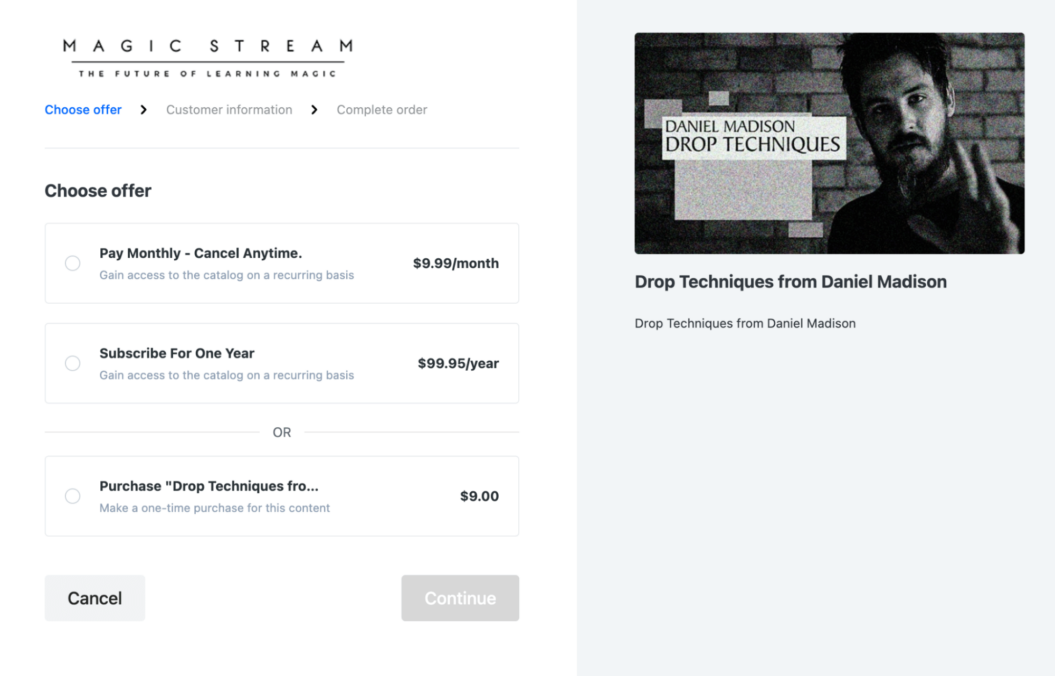
10 best video monetization platforms
However you choose to monetize video content, you need a video platform that supports your goals.
But before we look at the best video monetization platforms, it’s important to know what features you need to make a priority.
For example, if you want to monetize memberships and video courses, a beautiful viewing experience and community featurs are a must. However, if you want to sell brand sponsorships on social media, you’ll need a platform that helps you to reach a bigger audience.
With that in mind, let’s look at the top video monetization options for creators.
1. Uscreen

Uscreen is an all-in-one video monetization platform that gives you full control over your branding, audience, and income. You can easily create paid memberships that include an on-demand video library, livestreaming capabilities, and your own community space, all in your own branded site. You can also build branded TV and mobile apps through our OTT solution.
Uscreen is one of the top video monetization platforms that allows you to make the most of your creation with paid memberships that generate reliable revenue. With Uscreen as a video monetization platform, you can:
- Win loyal members with your own premium membership app.
- Maximize revenue potential with automated marketing tools and proven monetization approaches.
- Gain peace of mind by managing everything in one platform.
For everything your video business needs, you’ll find all the best monetization tools with Uscreen, including:
- Live streaming.
- Intuitive content management with catalogs and series.
- Mobile and TV apps.

With Uscreen’s video monetization platform, you can build a close-knit community alongside your video content.
This helps keep members around for longer, boosting your revenue while creating strong connections with your members. Our data shows that active community engagement results in 2 times less churn compared to creators with non-engaged members.
Let members showcase themselves by posting videos and having conversations with their peers.
Provide interactive, trackable challenges to keep members motivated and accountable.
And even take advantage of Uscreen’s AI Assistant to help generate post ideas, come up with titles, and streamline your editing experience.
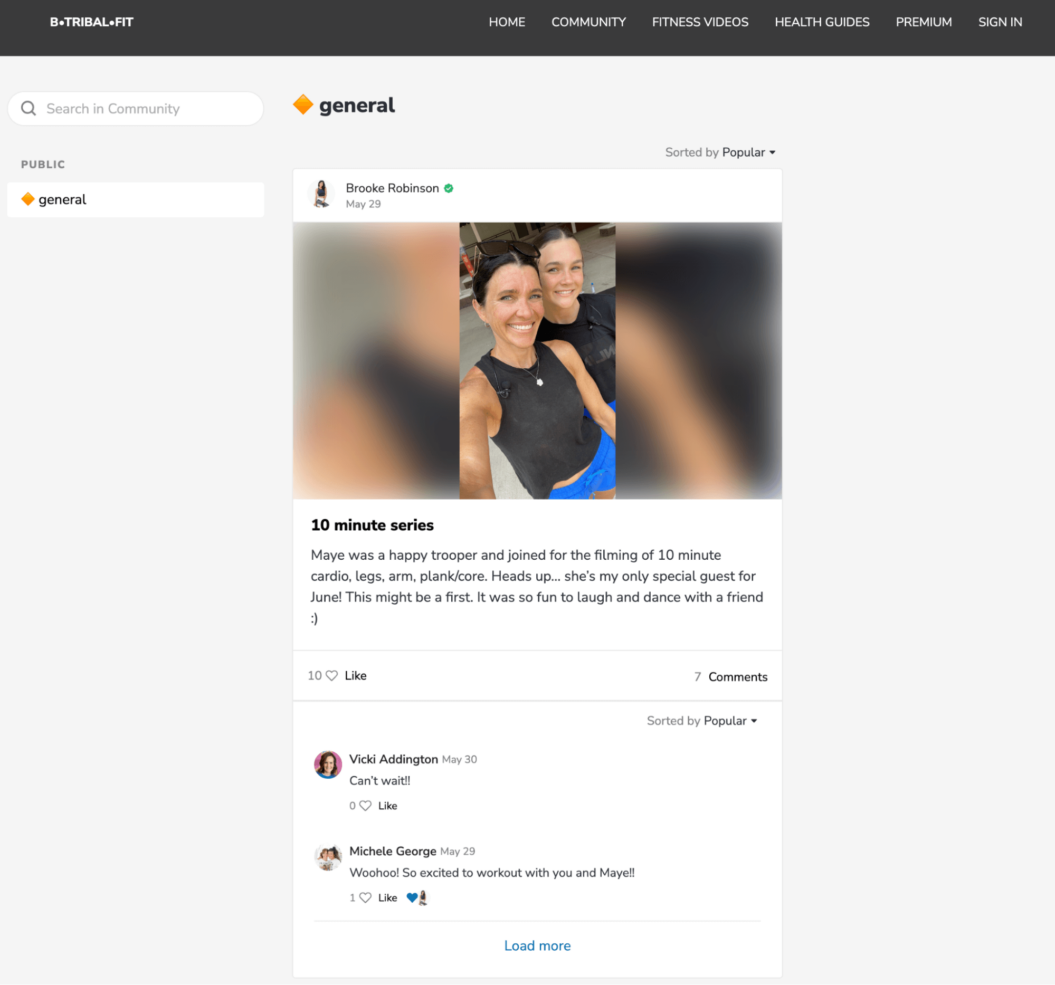
Uscreen also helps you create custom branded Over-The-Top (OTT) apps for platforms like iOS, Android, Apple TV, Roku, and more.
Members can access your content on their favorite devices and download content for offline viewing. On average, 70% of Uscreen customers get new subscribers from apps and earn 10x more subscription revenue than those who don’t use apps.
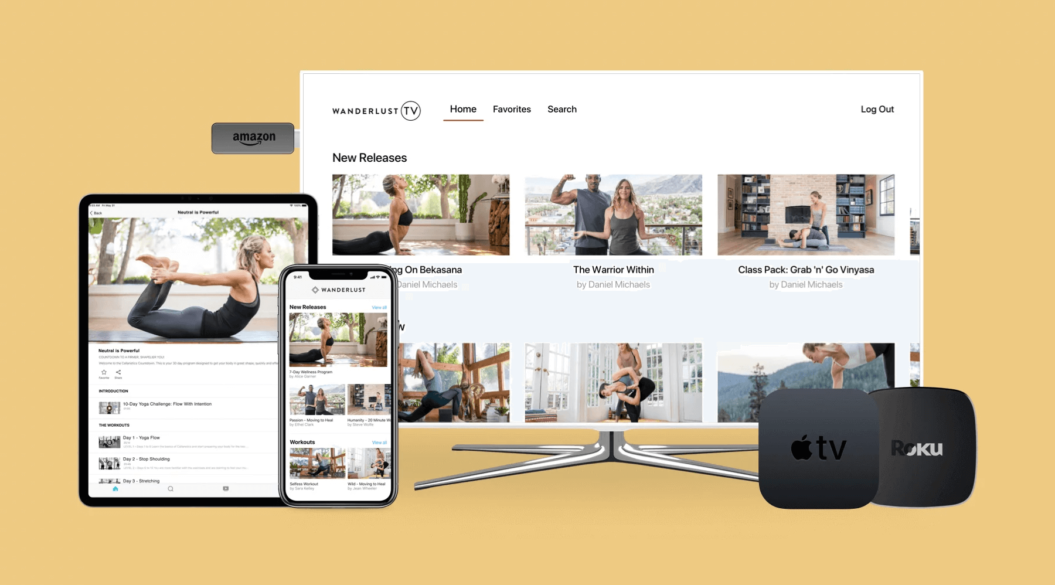
Case study: How the Bloom Method Scaled to $1M+ Annual Revenue
Brooke Cates envisioned Studio Bloom as a user-friendly, on-demand fitness platform tailored for “modern mamas”. Her goal was to provide an exceptional user experience with customer-focused features.

Initially, Studio Bloom experimented with platforms like Intelivideo and Vimeo, but encountered limitations. They needed a platform that could evolve with their growing needs. In June 2020, Studio Bloom migrated to Uscreen, a decision driven by Uscreen’s ability to meet their specific needs and support growth.
A big step for the brand was developing six mobile and TV apps, including an Apple Watch tracker app, in collaboration with Uscreen. These apps offered members easy access to customized programs, meditations, and community interaction, integrating seamlessly into their busy lifestyles.

By offering these apps, Studio Bloom positioned itself to compete with large platforms like Peloton and OB Fitness. With Uscreen, Studio Bloom’s revenue skyrocketed to over $87k a month, and they experienced a substantial increase in subscribers, including a 30% growth in just 3 months.
Platform Overview
Features:
- Customizable video player with media controls.
- Tiered membership options.
- Extensive branding and design options.
- Integrated growth-focused marketing tools.
- Popular checkout options like PayPal, Stripe, and credit card.
- Integrations with Mailchimp, LinkedIn, and more.
Pros:
- Exceptional video-focused platform.
- Seamless community integration.
- Versatile monetization methods.
- In-depth analytics and insights.
Payment methods: Integrates with Stripe, Payment, and its own Uscreen Payment Gateway.
Payment threshold: Payments received in a month are held for 30 days and then paid out on the 1st of the next month.
Free trial: 14 days
Pricing:
- Basic package ($149/mo , plus $1.99 per paid member/mo): Lets you build your website, host your videos, tier your pricing, use our marketing tools, and access analytics.
- Growth package ($499/mo, plus $.99 per paid member/mo): Lets you integrate your own tools, add eCommerce elements to your site, and run an affiliate program.
- Uscreen Plus (Custom pricing): You can add live streaming and live chat to your site, and remove all Uscreen branding.
Build, launch and manage your membership, all in one place.
2. Vimeo
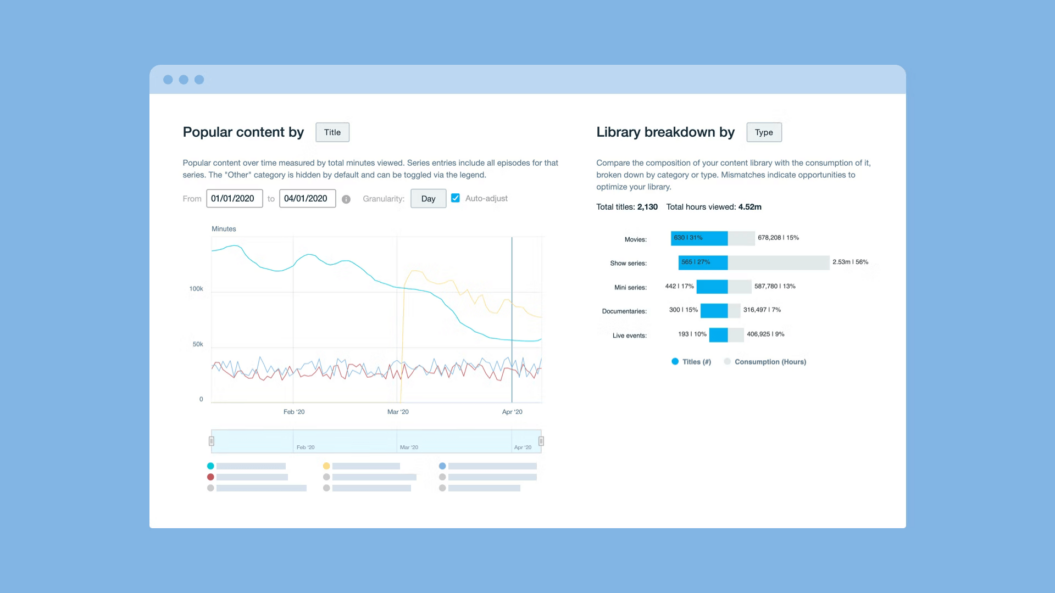
Vimeo is another video monetization solution that offers video-on-demand, OTT, and livestreaming. This video hosting platform gives you access to full-HD streaming, with an all-device video player so anyone can watch your video content.
You can stream videos on Vimeo, edit them, and share them. Overall, Vimeo’s focus is on providing a professional, ad-free environment with a lot of branding and customization options, unlike YouTube and Patreon.
The video platform also lets creators build apps. For example, ISC Sports Network got their streaming option off the ground as a “web-only” option, but quickly ramped up to 6 apps in 3 months, which helped increase its subscriber base by 180%.

You can also take advantage of polls, audience chat, and Q&As to engage with viewers. Vimeo doesn’t run third-party ads on your video content, which provides a clean and uninterrupted viewing experience for your audience.
Vimeo’s video monetization platform is suited for professional videographers, filmmakers, and businesses looking for more control over the presentation of their video content.
Creators often enjoy the platform’s professional-grade tools and supportive community, but struggle with the limited potential for organic discovery, since it’s not a social media platform.
As a monetization platform, earnings on Vimeo depend on many factors like views, promotional tactics, and monetization methods. The platform found that on average, creators earn $276 per 1,000 trailer views.
Platform Overview
Features:
- Supports TVOD, SVOD, and rentals.
- Powerful security tools.
- White-label video player.
- Simulcasting and multi streaming.
- Viewer engagement tools.
- Advanced privacy controls.
- Extensive video analytics.
- Integrations with third-party tools.
Pros:
- Global content delivery.
- High level of customization.
- Advanced analytics.
- Access to Vimeo’s video maker tool (Vimeo Create)
Cons:
- No ad revenue.
- Limited storage on a free plan.
Payment methods: A verified PayPal account is needed to receive earnings.
Payment thresholds: Payouts are made monthly, around 30 days after the end of the month. For example, sales made in June are paid in late July. A 2% fee applies for currency conversion if the transacted currency does not match the payout currency.
Free trial: 7 days for paid plans.
Pricing:
- Starter ($24 per seat / mo): Get the tools you need to make, manage, and share videos. 60 video maximum.
- Standard ($40 per seat / mo): Everything in Starter, plus more video marketing and customization features. 120 video maximum.
- Advanced ($130 per seat / mo): Everything in Starter and Standard plans, plus live streaming, virtual events, and marketing integrations. 500 video maximum.
Enterprise available with custom quote.
3. Muvi
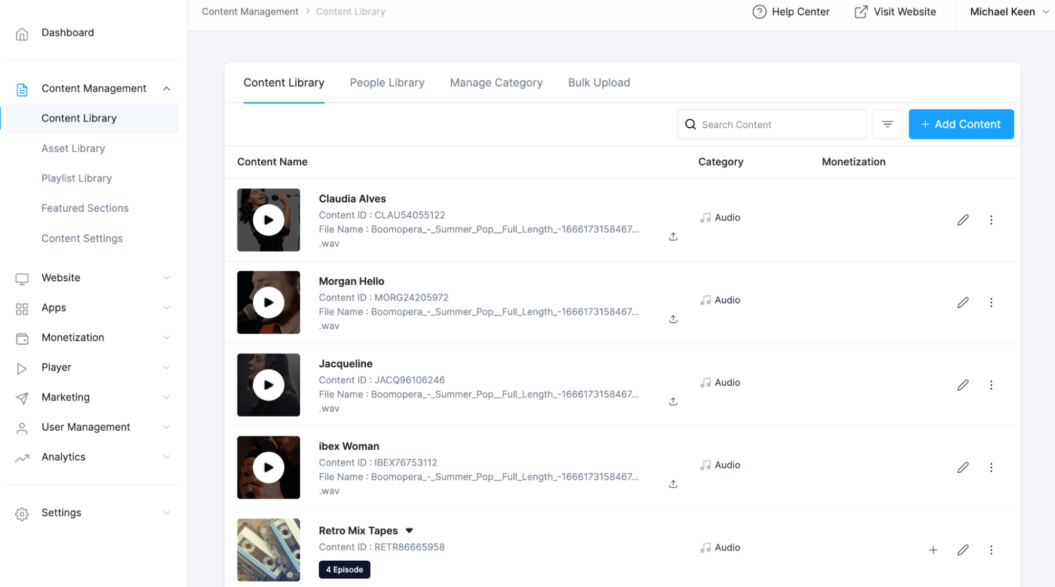
Muvi is well-known for its popular audio and video streaming platform, with an ecommerce edge. You can build custom video-on-demand channels for your brand.
With Muvi, you can monetize video content in a range of formats including Subscription Video on Demand (SVOD), Pay Per View (PPV), and Advertising Video on Demand (AVOD). Plus, with Muvi Kart, you can sell physical products to maximize sales. This dual monetization model is attractive if you want to generate revenue in multiple ways.
Muvi handles everything from IT infrastructure to payment gateways, so you can deliver content around the world. For example,
The Fort Smith International Film Festival, in its second annual edition, encountered challenges in screening 137 films from over 30 countries, tribes, and genres at a single location due to poor internet connectivity and the need to show multiple films simultaneously in different rooms.
To address these issues, Muvi recommended using its Muvi Live solution, integrating Muvi Playout, a cloud-based EPG style broadcast software. This software enabled the festival organizers to schedule and broadcast films across four rooms over two days from a single CMS dashboard, efficiently managing the increased upload time for over 130 movies.
The platform also integrates with all major social media platforms, so you can easily master Facebook monetization and Instagram monetization, while expanding your reach. You can even interact with followers, broadcast in real-time, and configure retargeting codes to improve your advertising efforts.
Platform Overview
Features:
- Tools to monetize through SVOD, PPV, AVOD, donations, and vouchers.
- Native mobile and TV apps.
- Advanced vCMS.
- Related content cards on videos.
- Full-featured, customized website.
- Option to watermark videos.
- Social media integration.
Pros:
- Unlimited video uploads and concurrent viewers.
- Quick and easy set up.
- Multi-platform support.
- Reliable customer support.
Cons:
- Limited website templates.
- Limited marketing tools.
Payment methods: Supports various payment gateways, including Stripe and mobile payment systems like M Paisa, IDeaBiz, MTN, TPay, and others.
Payment thresholds: Get 90% of your sales after transaction fees in a PayPal payment once a month.
Free trial: 14 days.
Pricing:
- Standard: $199/mo plus infrastructure fees.
- Professional: $499/mo plus infrastructure fees.
- Enterprise: $1,999/mo plus infrastructure fees.
4. Dacast

Dacast is a video monetization platform that offers video hosting for both live and on-demand content. It stands out for its user-friendly interface and robust streaming options, making it popular for broadcasters of all skill levels.
Dacast’s strength is in its white-label service. Compared to other platforms like Twitch or YouTube, you have full control over your branding. There are also less distractions because you’re not competing with other creators. Viewers only see your content when browsing your library.
One setback is the limited bandwidth you get from lower-tier plans, so it can get expensive the more viewers you have.
In the end, Dacast is a good choice for independent creators and medium-sized businesses with less technical knowledge. Dacast is cheaper than most video streaming platforms (only $39 per month), and you can broadcast and monetize content easily through it.
Platform Overview
Features:
- Global CDN.
- Video API access.
- Supports SVOD, TVOD, and AVOD.
- Reliable live streaming.
- RTMP and HLS channels.
- White-label video player.
- Real-time analytics.
Pros:
- Tools suited for creators.
- 24/7 customer support.
- China video hosting.
Cons:
- Extra fees for more viewers.
Payment methods: PayPal, check, money transfer (US and international)
Payment thresholds: Varies, but can be a minimum between $100 to $1,000.
Free trial: 14 days.
Pricing:
- Starter: $39/mo; 2.4 TB per year, 500 GB storage.
- Event: $63/mo; 6TB upfront, 250 GB storage.
- Scale: $165/mo; 24 TB per year, 2000 GB storage.
Custom plans are also available for high volume needs.
5. YouTube
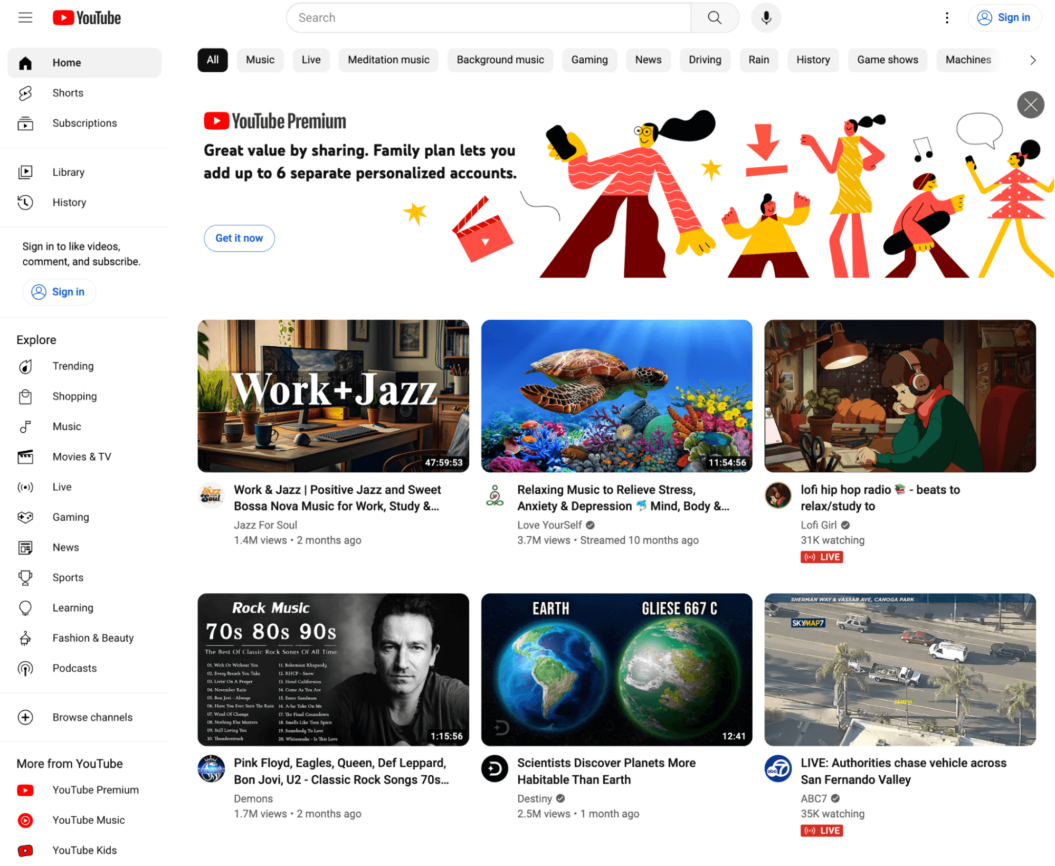
Thanks to the low barrier to entry, over 51 million creators try to monetize video content with YouTube, making it one of the top video monetization platforms.
YouTube gets 30+ billion monthly visits after all, and creators can sell everything from physical products to sponsorship slots — it’s a robust monetization platform. People spend over 23 hours per month on average on YouTube. Video streaming on YouTube is done through their website, mobile app, or smart TV app.
The video streaming platform offers a wide range of tools for creating, sharing, and monetizing video content. Your online video can also show up in Google Search if they are closely related to the searchers query, which helps your content get found by more people.
If you’ve ever skipped through video ads on the online video platform, you know that YouTube makes its money through advertising and creators get a cut when they’re eligible for monetization, which requires:
- An AdSense account.
- At least 1,000 subscribers.
- At least 4,000 valid public watch hours in the last year.
- Creators to live in specific countries or regions.
- Your channel has no active strikes against it.
Plus, you need to agree to the YouTube monetization policies. Compared to other content monetization platforms, YouTube’s monetization criteria are more stringent.
It might lead to high earnings down the road, but you have to commit to building a large subscriber base and produce regular content.
It’s also important to note that your viewership can be affected by algorithm changes, which happen frequently and are something you have no control over. Many creators use YouTube as part of their marketing strategy, and then convince subscribers to sign up for a membership on their own platforms.
YouTube handles all subscription payments and you get paid out through your AdSense account – which is usually between the 21st-26th of the month after you earned it. The typical earnings for YouTube content creators in the United States is around $1,321 per week, which equates to $5,726 per month, according to data from ZipRecruiter.
Platform Overview
Features:
- Adding a merch shelf to your channel.
- Create tiered subscription plans for premium content.
- Receive Super Chats and Super Likes on your live videos.
- Get a cut of subscription revenue when YouTube Premium members watch your content.
Pros:
- Massive built in audience.
- User-friendly interface.
- More visibility from ranking content on Google.
- Powerful analytics tools.
- Diverse revenue streams in one platform.
Cons:
- Can only reach viewers using YouTube.
- Frequent algorithm changes.
- Regular content required to stay relevant.
Payment methods: Check, Electronic Funds Transfer ETF), Single Euro Payments Area (SEPA), and wire transfer.
Payment thresholds: $100.Pricing: Free to host videos on a YouTube channel. The platform takes a cut of your earnings from ad revenue, subscriptions, and merch sales.
6. Patreon

Patreon is a video monetization platform that allows creators to generate a monthly revenue stream that’s not tied down to one video hosting platform.
This means you can ask your audiences from Telegram, Discord, and any other networks to support you on Patreon and still get your content on their chosen platform. It’s a great YouTube monetization alternative if you don’t meet the eligibility requirements, or just want an easy way to try out monthly subscription video monetization.
Content hosting and fan interaction are what make Patreon different from YouTube or Twitch, which primarily focus on video ads and viewership. It’s great for artists, musicians, podcasters, and other content creators who want to connect with their audience more directly.
Nearly half of all creators on Patreon produce content within these 4 categories: video, podcasts, music, and gaming. Patreon works best for creators who already have a dedicated audience that’s willing to pay for their quality content.
Take Knitty, a Patreon creator, for example. The online magazine, launched in 2002, has all types of content out there, from YouTube videos to articles. It currently has 2,965 paying members and has support tiers that range from $3.50 to $100.

Even on the lowest end, if all members paid $3.50 for every issue, that’s $10,377.50 in revenue.
Earnings vary depending on your membership tiers and audience, but you can get an idea of earning potential on Patreon by looking at Knitty’s profile.
It can take time to grow a big patron base, and some creators may find the platform’s revenue-sharing model to be a slow way to monetize content, particularly when compared to ad revenue or membership fees.
Platform Overview
Features:
- Membership tiers.
- Dedicated creator page.
- Direct messaging and community.
- Integrations with platforms like Discord and MailChimp.
- Detailed analytics and insights.
Pros:
- Direct relationship with fans.
- Offer rewards to patrons.
- Set your own prices.
- No algorithm changes.
Cons:
- Expensive platform fee.
- Tough for newer creators to get traction.
Payment methods: Direct deposit (US payout), PayPal, Payoneer.
Payment thresholds: Automatic payouts on the 5th of each month, no matter the balance.
Free trial: It’s free to start a Patreon page.
Pricing:
- Pro: 8% of the income you earn on Patreon.
- Premium: 12% of the income you earn on Patreon.
7. Twitch
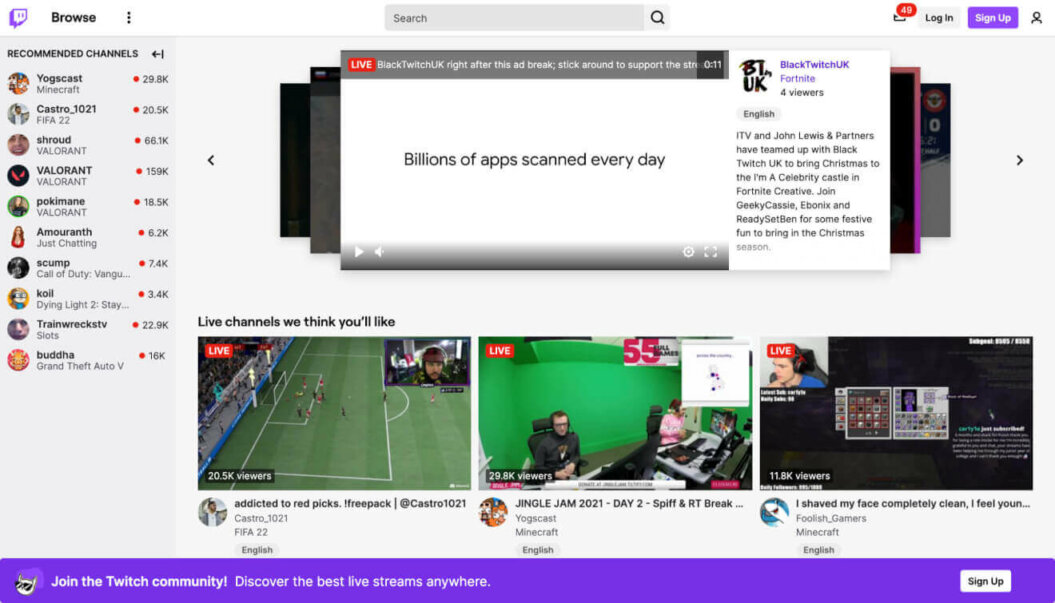
Twitch made its name as a streaming service for gamers and after being bought out by Amazon in 2014, it’s since expanded to artists, musicians, and other video creators alike.
Twitch is now considered the best video monetization platform for creators in the gaming niche.
The platform is dominated by live streams, with most of the VOD content being recordings of live streams. And an average of 2.45 million people were watching Twitch at any one moment in 2023, which is impressive.
Twitch is primarily known for its live streaming services, interactive chat, and community-building tools. It stands out among alternatives with its focus on gaming, but it also supports other categories like talk shows, IRL streams, cooking shows, educational content, travel, and more.
When it comes to earnings, estimates vary. Small streamers can earn anywhere between $50 and $1,500 per month, depending on how many views they have. Larger streamers can earn up to $6,000 per month streaming around 40 hours per week. The top streamer on Twitch, Ninja, has over 19 million followers and earns well over $500,000 per month, according to reports.

Twitch monetization is pretty straightforward. You can sign up to the Twitch Affiliate or Partner program that lets you earn money through:
- A 3-tiered subscription model.
- Users spending Bits and using Cheermotes.
- Selling games.
However, it’s important to remember that only Partners can get a cut of advertising revenue.
In terms of marketing strategy, Twitch has started to offer multi-month discounts. As we’ve seen with the last couple of platforms, your subscribers pay Twitch and you get your money directly – the payout comes on the 15th of the next month after you earned it.
To become a Twitch Affiliate, you need:
- A minimum of 500 streamed minutes in the last month.
- At least 7 unique broadcast days in the last month.
- An average of at least 3 concurrent viewers in the last month.
- 50 or more followers.
While to become a Partner, you need to:
- Stream for 25 hours.
- Broadcast on at least 12 days.
- Have at least 75 concurrent viewers.
Platform Overview
Features:
- Live streaming and VOD.
- Chat interaction.
- Channels and categories.
- Clips and highlights.
- Bounty Board for sponsorship opportunities.
- Broadcasting.
- Moderation tools.
Pros:
- Platform supports various monetization features (ad revenue, subscriptions, tipping, merch sales)
- Live interactions.
- Prime Gaming.
- Affiliate and Partner programs.
Cons:
- Highly competitive.
- Not suited for pre-recorded or edited content.
- Fees and payout policy.
Payment methods: Direct deposit, PayPal, checks.
Payment thresholds: $100
Free trial: Free to create an account.
Pricing: 50/50 revenue split.
8. TikTok

TikTok has seen massive growth since its launch in 2016, with over 1.4 billion monthly active users.
It’s a short-form video sharing platform known for its viral content and creative tools. It’s especially famous for its music, dance, and challenge videos. Compared to other platforms, TikTok offers a more engaging user experience with its powerful algorithm and unique content format.
Videos on TikTok are limited to 3 minutes and can be discovered by users scrolling through videos on their For You tab or searching for content within the Discover tab.
The current monetization model is a little different to what we’ve already seen on other video monetization platforms. Creators earn money through the Creator Fund, a pool of money that pays you based on viewership, engagement, and your adherence to community policies, plus you can access the Creator Marketplace to find brand sponsorships for your content.
TikTok is best for young, creative individuals looking to create a large volume of video content, build a following quickly, and engage in trends. Key elements that attract creators include an algorithm that amplifies views, live streaming, in-feed ads, TikTok Shopping, analytics, and donations. You can get paid through PayPal or Zelle one month after you earned money on the platform.
To be eligible for the TikTok Creator Fund, you must live in…
- the USA
- the UK
- Germany
- Italy
- France
- Spain
…and be over 18 years old.
Your channel also must have:
- 10,000 authentic followers.
- 100,000 authentic views.
- Original content posted on your account.
Creator earnings vary based on engagement and popularity of your content. TikTok pays between $0.02 and $0.04 per 1,000 viewers through the Creator Fund. However, you can use TikTok much like YouTube and drive followers to your membership website or digital home where you sell products.
All in all, TikTok isn’t a great video monetization platform if you’re relying on payouts alone. But, you can always boost your earnings with sponsorships!
Platform Overview
Features:
- Live streaming.
- TikTok Shopping.
- In-feed Ads.
- Analytics.
- Donations.
- Creator marketplace.
Pros:
- Big and active user base.
- Powerful algorithm.
- Multiple monetization options.
Cons:
- Fierce competition with other creators.
- Content restrictions.
- Zero control over distribution.
Payment methods: PayPal or Zelle.
Payment thresholds: $10.
Free trial: Free to create an account.
Pricing: Pay is based on video and live event metrics.
9. TargetVideo

With its unique approach to monetizing video, TargetVideo (formerly Brid.TV) has been gaining attention in the video monetization world. Using TargetVideo, you can run a wide variety of video ads on your content, from instream to outstream, and sticky ads that stay on your users’ screens as they scroll.
TargetVideo uses programmatic technology to deliver ads and generate revenue. So brands get better results and you get more money from them. It’s also got Managed Ads, so you can let a team handle everything and keep making amazing video content.
Or, you can use the automated Prebid Price Floor Optimizer with TargetVideo and let it do all the work. You just have to choose the ad placement in your videos.
If you’re a media company or video that wants a more customized ad experience, TargetVideo is a good fit. Note that you may need some technical knowledge to do extensive customization. TargetVideo offers a range of APIs and SDKs, including a Platform API and a Player API, along with Android and iOS SDKs.
Platform Overview
Features:
- Video header bidding.
- Ad yield optimization.
- Video CMS and Platform.
- Live streaming
- tvOS and mobile SDKs.
- Advanced ad targeting.
- WordPress video plugin.
- AI content matching.
Pros:
- High level of customization.
- Control over ad placements.
- Ability to earn revenue through targeted ads.
Cons:
- OTT apps only available on Custom Plan.
- Limited Starter Plan.
- No native SVOD (subscription video-on-demand) or TVOD (transactional video-on-demand).
Payment methods: PayPal, wire transfer.
Payment thresholds: $100. Net 30-day payment cycle.
Free trial: 1- month free trial available.
Pricing: Paid plans start at $49 per month.
10. Brightcove

Last up on our list of video monetization platforms is Brightcove.
Brightcove is one of the pioneers in video streaming and monetization founded in 2004. It’s used mainly by enterprises for corporate communications and streaming commercial video content to over 175 countries. With Brightcove, you can deliver flawless video content across various platforms like mobile, web, and smart TVs.
When it comes to monetization, Brightcove supports different video monetization models, from AVOD and TVOD to SVOD. The brand also has services for server-side and client-side ad insertion, ad server management, and consultations to help optimize the ad revenue you generate from video content.
Another benefit: Brightcove is known as the most reliable video platform with a 99.95% uptime. It also offers robust security features like studio-grade content protection measures, regional data storage, IP restriction and URL tokenization, and proxy restrictions.
Brightcove also aligns with ISO 27001 standards and has security certifications through the Digital Production Partnership (DPP) and CSA STAR registry.
Platform Overview
Features:
- Scalable delivery for large audiences.
- Audience engagement tools.
- Media Studio integration.
- Ad monetization services.
- Audience insights.
Pros:
- Reliable video streaming.
- Multiple monetization models.
- Robust security and content management features.
Cons:
- Complex platform.
- More for corporate entities.
- Expensive.
Payment methods: N/A
Payment thresholds: N/A
Free trial: Yes, for up to five uploaded videos.
Pricing: Quotation-based.
How to choose a video monetization platform
All the best video monetization platforms we’ve looked at are great at what they do. You can reach different audiences, make money in different ways, and benefit from different monetization models.
Here are a few criteria to look at when shopping for a online video monetization platform:
- Video monetization models: Make money based on your business model. Ad monetization platforms can make a lot of sense if you have a large audience and a lot of video content. Pay-per-view and subscription-based platforms like Uscreen can help generate revenue to provide a recurring income.
- Marketing tools: Getting your content out there is the first step to making money. It’s great to reach people on YouTube or TikTok, but creating a community or owning your audience is even more valuable.
- Access to money: Choosing a video monetization platform that pays when your bank account needs it is crucial. Depending on the creator, some will be content with a monthly payout, while others will want cash out to cover expenses like affiliate commissions.
- Ease of use: The platform should be easy to use for both creators and viewers. Creators should be able to upload, manage, and monetize videos without too much hassle. Viewers should find the platform user-friendly, with a good user interface and UX.
- Content ownership: Who owns the rights to your exclusive content when it’s uploaded? Some platforms may take a certain level of ownership over your content, so it’s essential to understand any rights you may be giving up.
- Pricing: Consider the cost of a paid platform. Platforms charge flat fees or a percentage of earnings. Based on your expected revenue and video views, calculate which model would be most profitable.
- Customer support: Good customer support is essential. If you encounter problems with video uploads, monetization, or anything else, you’ll want a platform that responds quickly.
That’s our guide to the best video monetization platforms, let’s bring this to a close.
Find the right platform for your video monetization strategy
There’s no one-size-fits-all approach to monetizing video.
But if you want recurring revenue on an owned platform then membership monetization could be the way to go. Why?
Because, with memberships, you can still mix and match different monetization strategies like advertising, subscriptions, merchandise sales, and sponsorships for more revenue streams.
Remember to stay open to new ideas and optimize your strategies as your audience and the market evolves. With the right approach, you can turn your passion for video creation into a profitable and fulfilling career.
Video monetization FAQs
The easiest monetization platform for new creators often depends on the content they make. But platforms like TikTok and YouTube are generally easiest because the platforms are familiar and accessible for newcomers.
The platform that pays the most depends on your content and audience size. YouTube, for example, can offer high earning potential when you combine ad revenue, sponsorships, and Super Chats. Twitch can also offer lucrative opportunities through subscriptions and donations.
A creator’s most profitable platform is usually where their content resonates the most with their audience. For video creators, Uscreen can be very profitable due to its membership and community features. Patreon provides a steady income to artists and writers. Gamers will likely prefer Twitch and YouTube for its monetization options.






